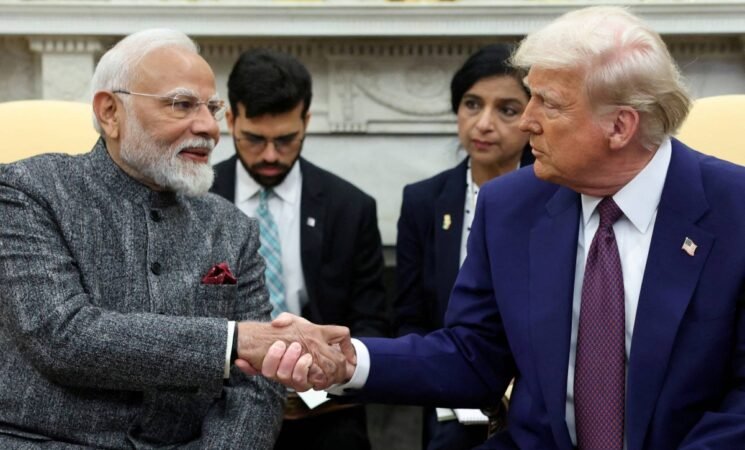31 July 2025, NIICE Commentary 11514
Sunil Kumar Chaudhary
The world of international trade is a high-stakes driver of economic relations among the nations. The latest moves by the US have left observers wondering if they are witnessing a masterstroke or a miscalculation. The imposition of a 25% tariff on Indian goods, coupled with an unspecified “penalty” for India’s ongoing trade with Russia, has sent shockwaves through both economies. Is this an effort to rebalance a perceived unfair trade relationship, or is it a calculated power play designed to bend India to America’s will? The answer, it seems, is a complex mix of both.
The official justification for the tariffs is familiar, echoing a rhetoric that has defined US trade policy for some time. The President cited India’s “far too high” tariffs and “strenuous and obnoxious non-monetary trade barriers.” He pointed to the goods trade deficit, which reached an estimated $45.7 billion in 2024, as evidence of an unbalanced relationship that needs to be remedied. From this perspective, the tariffs are a straightforward policy tool - a stick to be wielded to force a more reciprocal trade agreement. The goal is to open up India’s vast and growing market for American products, particularly in politically sensitive sectors like agriculture and dairy, where India’s protective policies have long been a source of frustration for Washington.
The tariffs are a blunt instrument, and their application to a country like India, which the US has long courted as a strategic partner, suggests a deeper, more geopolitical motivation. The inclusion of a penalty for India’s trade with Russia is a particularly telling detail. This is an explicit attempt to use economic leverage to influence India’s independent foreign policy. India has maintained a delicate balance in its relationships with global powers, and its ties to Russia. Russia is a major supplier of defense equipment and, more recently, discounted energy, which are a cornerstone of this approach. By linking tariffs to these ties, the US is essentially saying: “Choose us or face the consequences.”
This is where the argument of a “policy blunder” comes into play. The US, in its desire to punish Russia and bring India into its orbit, may have underestimated India’s resolve. The Indian government has made it clear that its primary objective is to protect its national interests, including the livelihoods of millions of farmers and small businesses that would be devastated by an influx of cheap American goods. India’s commerce minister has repeatedly stated that a trade deal will only be signed if it is fair, balanced and mutually beneficial. This firm stance, coupled with a renewed focus on domestic manufacturing and export diversification, suggests that India will not be easily swayed by a pressure-driven approach.
Moreover, the new tariffs put India at a significant competitive disadvantage compared to its regional rivals. While countries like Japan and South Korea have negotiated more favorable tariff rates with the US, India is facing a blanket 25% duty on virtually all its exports. This could have a devastating impact on labor-intensive sectors like textiles, gems and jewelry, and petrochemicals, which are key drivers of employment in India. The move also complicates the efforts of American companies, like Apple, that have been building a manufacturing base in India as an alternative to China. This inconsistency - pushing for a decoupling from China while simultaneously making Indian exports less competitive. It raises questions about the long-term coherence of the US’s trade strategy.
The timing of the tariffs also adds to the complexity. They were announced just before a pre-set deadline for a trade deal, and a US delegation is scheduled to visit India for further talks. This timing suggests that the tariffs are indeed a negotiating tactic. This is a dramatic escalation designed to create a sense of urgency and force India’s hand. From this perspective, the tariffs are not the end of the story, but the beginning of a more intense phase of negotiations. The hope in Washington may be that the economic pain of the tariffs will push New Delhi to the negotiating table with a greater sense of compromise.
However, this is a dangerous game. For India, a country with a proud history of strategic autonomy, giving in to such pressure could be seen as a sign of weakness. It could embolden other countries to try similar tactics, and it could damage the political standing of the government at home. The Indian market has not crashed, and while there is concern in export circles, there is also a sense of defiance and a belief that India can weather the storm. The long-term vision is to diversify away from a reliance on any single market, including the US, and to build a more resilient and self-sufficient economy.
Whether Trump’s tariffs are a policy blunder or a power play will depend on the outcome. If they lead to a comprehensive trade deal that benefits both countries, they could be seen in retrospect as a necessary, if heavy-handed, negotiating tactic. But if they lead to a prolonged trade war, a deepening of distrust, and a further distancing of India from the US’s strategic goals, they will be remembered as a costly misstep. The path forward for both nations is narrow and fraught with risk. The true test will be whether they can navigate the geopolitical currents and find common ground, or whether the current tensions will prove to be a defining moment that drives them further apart.

